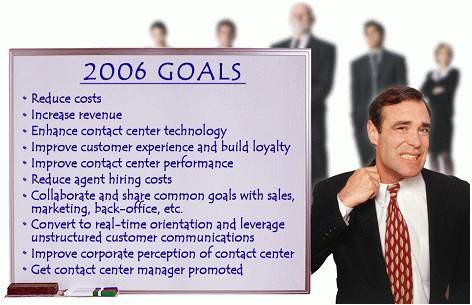 World-class contact centers are not the result of luck or chance. World-class contact centers evolve, over time, under the direction of highly skilled and inspired leaders. Contact center managers today cannot be satisfied with merely doing more with less. They must continually refine and orchestrate people, process and technology to fulfill the contact centers fundamental mission of providing an outstanding customer experience at the lowest possible cost. They must also contribute to enterprise revenue, profitability and analytics goals that were previously the responsibility of sales and marketing.
World-class contact centers are not the result of luck or chance. World-class contact centers evolve, over time, under the direction of highly skilled and inspired leaders. Contact center managers today cannot be satisfied with merely doing more with less. They must continually refine and orchestrate people, process and technology to fulfill the contact centers fundamental mission of providing an outstanding customer experience at the lowest possible cost. They must also contribute to enterprise revenue, profitability and analytics goals that were previously the responsibility of sales and marketing.
World-Class Contact Centers
In 2006, leading contact center managers are being asked to meet contact center and enterprise goals reaching far beyond the boundaries of their operating environment. Here are the top ten contact center challenges for 2006. (See Figure One.) Contact center managers who want to get ahead (or at least earn their bonuses in 2006) must have plans for achieving these goals.
1. Reduce costs. Cost reduction remains a top priority for contact center managers. But now, contact center managers are expected to meet their own cost savings objectives and help other departments to do the same. Develop cost reduction initiatives that are not merely focused on people but encompass all aspects of business process optimization.
2. Increase revenue. Sales and marketing want assistance in achieving revenue goals. As the focal point of customer communication, contact centers are ideally positioned to generate revenue and contribute significantly to the companys bottom line. Reach out to peers in sales and marketing to offer the contact centers assistance. Find out how to help them meet their goals and then implement processes to ensure that customer information is shared with decision makers on a timely basis. Leverage the contact centers knowledge of customer needs, wants and insights to maximize revenue from every appropriate customer transaction.
Donna Fluss is the Principal of DMG Consulting LLC, delivering customer-focused business strategy, operations and technology for Global 2000 and emerging companies. Ms. Fluss, a recognized leader and contact center visionary, is a highly sought-after writer and speaker. She is the author of The Real-Time Contact Center, published in August 2005. Contact Ms. Fluss at donna.fluss@dmgconsult.com.
3. Enhance contact center technology. Identify and implement technology innovations to increase the contact centers productivity and provide value-added capabilities. Find innovative applications, such as speech analytics, to optimize the contact centers performance and increase its benefit to the enterprise.
4. Improve customer experience and build loyalty. Customers should be given the flexibility to use whichever channel is most convenient at any given time and should expect to receive the same outstanding service in all channels. Improve and standardize the customer experience across all channels. Establish uniform and consistent quality metrics across all channels. Monitor customer satisfaction on an ongoing basis with surveys to ensure alignment of quality measurements with customer satisfaction. People choose to do business with companies that provide outstanding service and satisfy their needs throughout the customer life cycle. Use analytics to identify new opportunities and proactively engage customers in their channel of choice. Build loyal customers the old fashioned way consistently provide outstanding service and give them no reason to look elsewhere.
5. Improve contact center performance. The contact center must adapt to the changing needs of the enterprise and its customers, without losing site of its primary mission addressing the reasons why customers initiate contact with the organization, whether to ask a question or to purchase a product. Annually, strive to increase service quality and customer satisfaction. Continuously raise the bar for service excellence, as this is essential for meeting all other objectives.
6. Reduce agent hiring costs. Agent-related expenses from salaries to training and recruitment represent the largest expense category for all contact centers, regardless of their purpose or where they are located. Contact centers are high-stress environments and it takes creative leadership supported by good infrastructure to retain agents. Reducing agent attrition by a few percentage points will save thousands of dollars and possibly a great deal more for contact centers of all sizes. Invest in recruitment tools to be able to identify optimal recruitment channels and track the entire agent life cycle. Implement eLearning and coaching modules to improve agent communication, get agents more involved in contact center activities and improve training effectiveness.
7. Collaborate and share common goals with sales, marketing, back office, etc. The activities and programs of the marketing department, billing organization, credit policies, etc., directly impact the contact center. The quality of service provided by the contact center impacts the outcomes of sales and marketing programs and all other initiatives that affect customers. When sales, marketing, service and operations work together, the corporation and its customers win. Contact centers should engage their peers in sales, marketing, and operations and offer their assistance. Proactively engage managers in other departments and encourage meetings to discuss priorities and establish shared goals to enhance the bottom line and improve the customer experience.
8. Convert to real-time orientation and leverage unstructured customer communications. Customers have made it clear to enterprises that they want their issues resolved in real time or as close to real time as possible. Its also a great deal less expensive to resolve an inquiry during the first customer contact than to have to follow up with customers (whether via phone calls or emails) or ask them to get back in touch with you. Contact centers need to convert their reactive processes into more real-time activities, even if it means increasing the average handle time. Use contact center performance management applications to take a 360-degree view of agent performance and determine the most satisfying and cost effective procedures. Review all relevant metrics transaction handle time, sales closure or referral rates, quality management scores and customer satisfaction ratings dont just pay attention to productivity measures. Invest in new analytical offerings, such as real-time analytics and speech analytics, to analyze and structure customer communications and enable the contact center to proactively engage customers with services and offerings that provide an outstanding overall experience. Its time for enterprises to leverage unstructured customer communications to identify insights, new opportunities, issues, wants and trends in order to improve operations, increase revenue, improve customer satisfaction and build loyalty. Contact centers should use this information to improve their day-to-day activities, reduce service transaction and to make customer insights and needs available to other parts of the organization. Capitalize on this actionable intelligence to engage customers at the point of contact. It will give both the contact center and the enterprise a strategic advantage.
9. Improve corporate perception of the contact center. The contact center is a key contributor to the success of the enterprise. Open up the contact center to the enterprise by establishing a formal process for capturing, identifying and sharing actionable customer data to contribute to the success of strategic corporate initiatives. Participate in corporate strategy sessions and invite sales and marketing to participate in contact center decisions.
10. Get contact center manager promoted. Contact center managers need to be politically adept leaders, and as knowledgable about sales, marketing, IT and finance as they are about service. In order to gain the respect of peers, management must broaden its focus and develop a clearer understanding of sales, marketing and corporate objectives and goals. Contact center managers must continue to achieve their departmental goals, but to get ahead they must also prioritize enterprise objectives.
Figure One: 2006 Contact Center Goals
DMG Consulting LLC

What This Means For You
World-class contact centers operate on the philosophy of constant change and innovation. While technology is an important enabler of change and innovation, it is leadership that creates the strategy, implements the technology, optimizes the process and people and drives change. As contact centers transition to a strategic enterprise asset, so too must the role of the contact center manager evolve. Contact center managers should use this list of goals as a starting point for managing their departments transition from a reactive, cost-oriented, environment to an engaged and proactive organization that is as dedicated to providing each and every customer with an outstanding experience as it is to contributing to enterprise profitability goals.
Donna Fluss is the Principal of DMG Consulting LLC, delivering customer-focused business strategy, operations and technology for Global 2000 and emerging companies. Ms. Fluss, a recognized leader and contact center visionary, is a highly sought-after writer and speaker. She is the author of The Real-Time Contact Center, published in August 2005. Contact Ms. Fluss at donna.fluss@dmgconsult.com.
2006-03-13
Em Foco – Opinião

